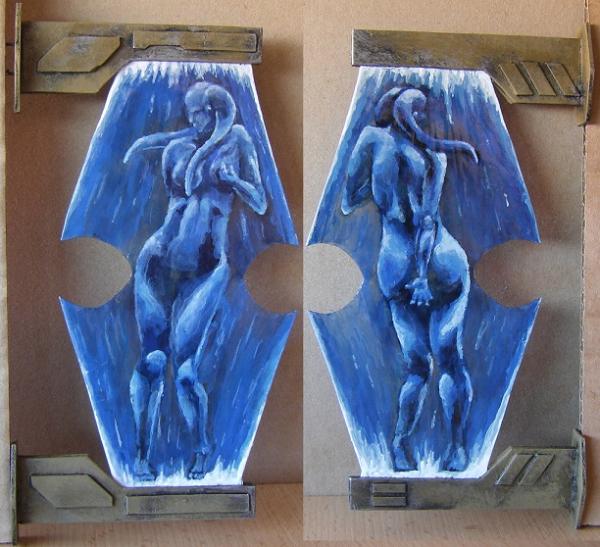I just finished an addition to my group's nightclub terrain piece and this is totally a showoff post.


Now that that part is done, I have a few thoughts on technique and material here.
The whole thing started out with the idea of doing a somewhat translucent holographic sign (since that's what you see in the movies and other media) and to my great surprise it even worked out. Not that I don't have a measure of confidence in my abilities, but I've never painted on a translucent surface before and didn't have a clue what to expect.
The holo image is cut from a blister pack that I coated with gloss varnish because paint won't stick to the bare plastic very well, given a coat of black wash to shape the figure of the dancer and a blue wash all over to give it a unified blue appearance (because again, blue tint is the foremost quality in the source material). Then some freehanding topped off with another coat of gloss varnish which brings out the translucency on the less pigmented parts (that is mostly the blue static around the dancer).
Fun bits:
Once you get a clear coat on the plastic, it's great that you can the put a paper cutout underneath it with a sketch of the dancer. Makes painting the thing a lot easier and doesn't stain the actual piece with a crude sketch. It's also nice to have the same effect when you flip the piece around - you already have the correct shape sitting on the other die of the plastic. It's almost painting by numbers.
Twi'leks are blue. Holograms are blue. No need to figure out how the holo projection would tint other colors. Yay!
Whole project took a week from start to finish. The freehand, the fiddly part, was done in a day per side. That's nice and not too stressful. I don't like it when these things get drawn out.
Not so fun bits:
I painted the back two days after the front. Turns out I couldn't even remember quite what I did after two days and the back is slightly differently highlighted than the front. Additionally, it doesn't help that the front was my first try with experience to draw on, while the back has the benefit of hindsight and let me adjust things for a smoother painting session. Different models getting better through experience? Yay! Bits on the same model looking different by applying what I've learned immediately? Eh, that's dodgy.
Brushstrokes. Not so bad on opaque models. On a translucent one, you see every mistake. Every. One.
Along those lines, I think by gloss varnish has seen better days. It seems prone to air bubbles and dries quickly intro streaks. Might have been an application error on my part, though. Or both.
The holo projectors are built with three layers. The one in the middle is cut to allow the projection to slot into it. Good idea to account for the added breadth paint and varnish add to the plastic. Nothing brute force can't fix, though.